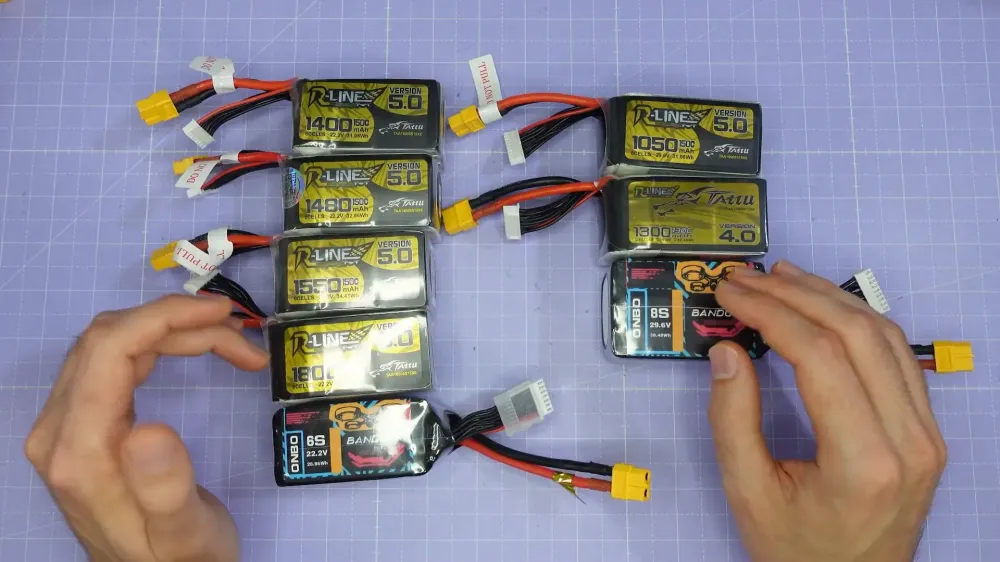Intro
In Chris Rosser's latest video, he explores the growing trend of using 8S battery packs in larger quads and even 5-inch quads. The aim? To uncover how much more power an 8S pack can deliver compared to a similarly weighted 6S pack. Alongside this, Chris conducts thorough battery testing using a new lineup of batteries from Tattu and Onbo in both 6S and 8S configurations.
With a wealth of data to unpack, Chris dives straight into the performance comparisons and insights drawn from the tests.
Get the full data!
If you're keen on a comprehensive comparison of all the 6S batteries tested up until now, including the new contenders, Chris provides a link to AOS RC for full data, recommendations, and more.
Batteries on Test
The batteries put to the test include several Tattu R-Line V5 options: 1400mAh, 1480mAh, 1550mAh, and 1800mAh in 6S, along with 1050mAh and 1300mAh in 8S. Additionally, two Onbo Bando K packs (both 1300mAh) in 6S and 8S configurations are included for comparison.

Direct 6S to 8S Comparisons!
Chris highlights an intriguing aspect of the comparison: despite the 1050mAh and 1400mAh packs sharing a nominal watt-hour rating of 31.08, they differ in weight. The 8S pack weighs 241.8 grams, while the 6S pack weighs 228.2 grams. This weight discrepancy is crucial in understanding performance outcomes.
6S Constant Power Discharge Test
The constant power discharge test for the 6S packs is conducted at 15C times their nominal voltage of 22.2 volts, from a fully charged state down to a cutoff of 3.3 volts per cell. The results reveal that larger packs, such as the 1800mAh Tattu R-Line V5, deliver more energy than their smaller counterparts.
8S Constant Power Discharge Test
In the 8S test, the same principles apply, with discharge at 15C times a nominal voltage of 29.6 volts. The larger packs again show a trend of delivering more energy, showcasing the importance of size in performance.
Energy Delivered (Wh rating)
Overall, Chris notes satisfaction with the energy delivered compared to rated energy. The Onbo Bando K packs performed exceptionally well, matching their rated energy closely, while the Tattu packs also yielded good results. However, the 1800mAh and 1300mAh packs delivered slightly less than their rated energy, likely due to variations in cutoff voltage standards.
6S vs 8S Energy Delivered
When comparing energy delivery, Chris found equivalence between the 6S 1800mAh pack and the 8S 1300mAh pack in terms of energy output. The performance of the 1050mAh and 1400mAh packs also showed similar energy delivery metrics.
Energy Density
Energy density, measured as watt-hours per gram, shows that both the Tattu R-Line V5 and Onbo Bando K packs are fairly similar, ranging from 0.125 to 0.135 watt-hours per gram. Interestingly, there seems to be no significant advantage of 8S over 6S in this metric.
6S Burst Discharge Test
The burst discharge testing for 6S packs follows a specific protocol, starting with zero current for three seconds, followed by a 15C discharge for 48 seconds. Chris observes some packs maintain higher voltages during this test, allowing them to deliver more power before hitting the cutoff.
8S Burst Discharge Test
Similar testing protocols are applied to the 8S packs, which start at a higher voltage of 33.6 volts. The results show that both 6S and 8S packs exhibit similar discharge curves and durations.
6S vs 8S Burst Performance
In terms of effective C rates, the Tattu R-Line V5 1800mAh pack achieved the highest rating at 74, while the highest performing 8S pack delivered an effective C rate of 68. Chris notes that all tested packs exceeded a C rate of 50, indicating robust performance across the board.
Effective C Rate
The effective C rate provides a comparison of how long each pack can sustain a specific discharge rate before dropping below the cutoff voltage. This metric is crucial for understanding the practical performance of each battery under load.
Maximum Burst Power
The maximum burst power graph illustrates the clear difference between the 6S and 8S packs. For instance, the Onbo Bando K 1300mAh 6S pack delivers approximately 1540 watts, while its 8S counterpart provides 2265 watts—a 33% increase in power output.
Power Density
Power density, which measures power output relative to weight, shows the Tattu R-Line V5 1800mAh pack leading the pack with over 9 watts per gram. This indicates exceptional performance, especially for FPV racing applications.
Recommendations
Chris concludes that all the new packs from Tattu and Onbo are top contenders in terms of performance. He emphasizes that when selecting between battery types, the weight of the pack is a better predictor of performance than just the milliamp hour rating. If two packs weigh similarly, their performance will likely be comparable, regardless of whether they are 6S or 8S.
FAQ
- What are the main differences between 6S and 8S batteries?8S batteries typically deliver more power due to having more cells, but performance also heavily depends on battery weight and construction.
- How important is energy density?Energy density is crucial as it indicates how much energy a battery can deliver relative to its weight, impacting overall flight performance.
- Should I switch to 8S batteries for my quad?Consider switching if you need more power and your quad can handle the additional weight, but ensure the weight and performance metrics align with your needs.




